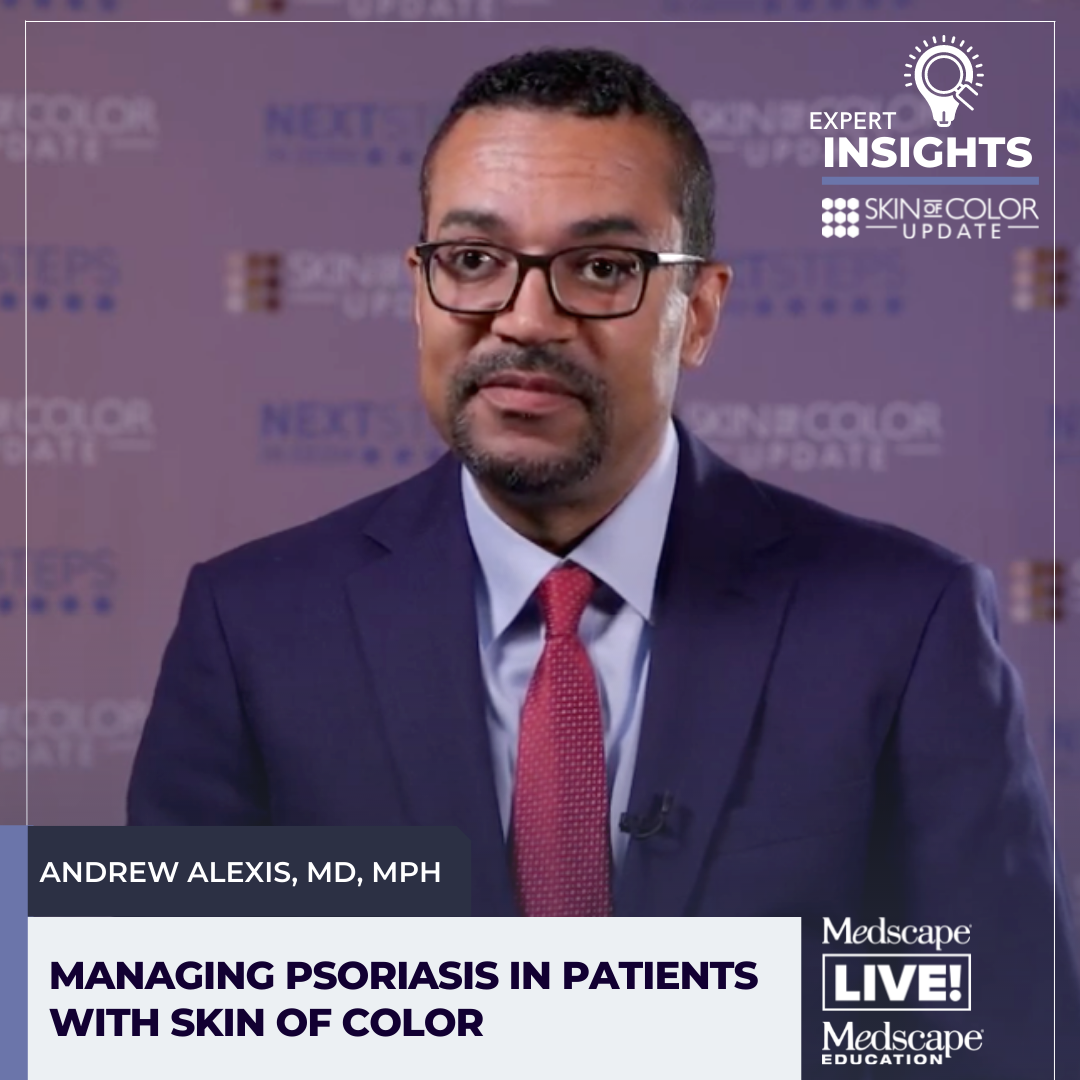The burden of psoriasis in patients with skin of color is significant, with reduced quality of life and often delayed diagnosis compared to patients with white skin. Andrew Alexis, MD, MPH, shares how he thinks learners will benefit from participating in this enduring educational activity from our symposium at the 2022 Skin of Color Update annual meeting in New York.
[/vc_column_text][/vc_column][/vc_row]
Watch the full discussion on treating psoriasis in patients with skin of color below!
Further Reading
If you would like to learn more about psoriasis, check out the following articles published in the Journal of Drugs in Dermatology:
Background: Roflumilast cream (ARQ-151) is a highly potent, selective phosphodiesterase-4 inhibitor in development for once-daily topical treatment of chronic plaque psoriasis.
Objectives: To assess the safety and efficacy of once-daily roflumilast cream 0.5% and 0.15% in patients with chronic plaque psoriasis.
Methods: This phase 1/2a study enrolled a single-dose, open-label cohort (Cohort 1: 0.5% cream applied to 25 cm² psoriatic plaques), and a 28-day, double-blinded cohort (Cohort 2: 1:1:1 randomization to roflumilast cream 0.5%, 0.15%, or vehicle). Patients had chronic plaque psoriasis of >6 months’ duration with ≤5% body surface area involvement. Outcomes included safety (adverse events) and efficacy (percentage change in the Target Plaque Severity Score [TPSS] × Target Plaque Area [TPA]) at week 4.
Results: For Cohorts 1 (n=8) and 2 (n=89), adverse events (all mild/moderate; none severe or serious) were similar between active arms and vehicle. Treatment-related events were confined to the application site, without differences between drug and vehicle. No patient discontinued treatment due to adverse events. The primary efficacy endpoint was met for both roflumilast cream doses: TPSS×TPA improvement at week 4 was statistically significant for roflumilast 0.5% (P=0.0007) and 0.15% (P=0.0011) versus vehicle; significance was reached as early as 2 weeks. For both roflumilast cream doses, 66%–67% improvement from baseline was observed at week 4, without reaching a plateau, versus 38% improvement for vehicle.
Conclusion: Roflumilast cream was safe and highly effective at doses of 0.5% and 0.15% and represents a potential novel once-daily topical therapy for the treatment of chronic plaque psoriasis.
ClinicalTrials.gov NCT03392168.
J Drugs Dermatol. 2020;19(8): doi:10.36849/JDD.2020.5370
![]() Fixed-Combination Halobetasol Propionate and Tazarotene Lotion for Psoriasis in Patients With Skin of Color
Fixed-Combination Halobetasol Propionate and Tazarotene Lotion for Psoriasis in Patients With Skin of Color
Background: Few studies have examined topical psoriasis therapies in patients with skin of color. Fixed-combination halobetasol propionate (0.01%) and tazarotene (0.045%) lotion (HP/TAZ) was investigated in two phase 3, multicenter, double-blind, vehicle-controlled trials (NCT02462070; NCT02462122). This post hoc analysis evaluated HP/TAZ in subgroups of non-White and White participants, including Hispanic/Latino participants, from these trials.
Methods: Adult participants were randomized (2:1) to receive HP/TAZ or vehicle lotion once daily for 8 weeks. Data were pooled and analyzed in non-mutually exclusive subgroups of self-identified non-White or White and Hispanic/Latino participants. Efficacy assessments included treatment success (≥2-grade improvement from baseline in investigator’s global assessment [IGA] and score of clear/almost clear), reduction from baseline in affected body surface area (BSA), and reduction in mean IGA × BSA. Safety was evaluated via treatment-emergent adverse events (TEAEs).
Results: Of 418 participants, 60 and 358 self-identified as non-White and White, respectively; 115 of 418 participants self-identified as Hispanic/Latino. At week 8, a higher percentage of HP/TAZ-treated participants achieved treatment success vs vehicle (non-White, 34.4% vs 19.0%; White, 41.8% vs 8.7%; Hispanic/Latino, 39.3% vs 9.3%); rates for White and Hispanic/Latino participants were statistically significant. Compared with vehicle, HP/TAZ-treated participants in each subgroup experienced numerically greater reductions in affected BSA and IGA × BSA at week 8. The most common TEAEs were contact dermatitis, pruritus, nasopharyngitis, and application-site pain; discontinuations due to TEAEs were few.
Conclusions: HP/TAZ reduced disease severity in non-White, White, and Hispanic/Latino participants with psoriasis, with good tolerability and safety over 8 weeks of treatment.
J Drugs Dermatol. 2021;20(7):735-744. doi:10.36849/JDD.6158
![]() Once-Daily Halobetasol Propionate 0.01% Lotion for Moderate-to-Severe Plaque Psoriasis: Phase 3 Analysis of Hispanic Participants
Once-Daily Halobetasol Propionate 0.01% Lotion for Moderate-to-Severe Plaque Psoriasis: Phase 3 Analysis of Hispanic Participants
Background: Psoriasis is a chronic, inflammatory disease that may differ in prevalence and clinical presentation among patients from various racial and ethnic groups. Two phase 3 studies demonstrated efficacy and safety of halobetasol propionate (HP) 0.01% lotion in the treatment of moderate-to-severe plaque psoriasis (NCT02514577, NCT02515097). These post hoc analyses evaluated HP 0.01% lotion in Hispanic participants.
Methods: Participants were randomized (2:1) to receive once-daily HP or vehicle lotion for 8 weeks, with a 4-week posttreatment follow-up. Post hoc efficacy assessments in Hispanic participants (HP, n=76; vehicle, n=43) included treatment success (≥2‑grade improvement in Investigator’s Global Assessment and score of ‘clear’ or ‘almost clear’), psoriasis signs, and affected body surface area (BSA). Treatment-emergent adverse events (TEAEs) were evaluated.
Results: At week 8, 38.8% of participants achieved treatment success with HP versus 10.3% on vehicle (P=0.001). HP‑treated participants achieved greater improvements in psoriasis signs, compared with vehicle (P<0.01 all). HP group had a greater reduction in affected BSA versus vehicle (P=0.001). Treatment-related TEAEs with HP were application site infection and dermatitis (n=1 each). Conclusions: Once-daily HP 0.01% lotion was associated with significant reductions in disease severity in Hispanic participants with moderate-to-severe psoriasis, with good tolerability and safety over 8 weeks.
J Drugs Dermatol. 20(3):252-258. doi:10.36849/JDD.2021.5698
Accreditation Statement
In support of improving patient care, Medscape LLC is jointly accredited by the Accreditation Council for Continuing Medical Education (ACCME), the Accreditation Council for Pharmacy Education (ACPE), and the American Nurses Credentialing Center (ANCC), to provide continuing education for the healthcare team.
For Physicians
Medscape, LLC designates this enduring material for a maximum of 0.75 AMA PRA Category 1 Credit(s)™. Physicians should claim only the credit commensurate with the extent of their participation in the activity.
Did you enjoy this post? Find more on skin of color dermatology here.

